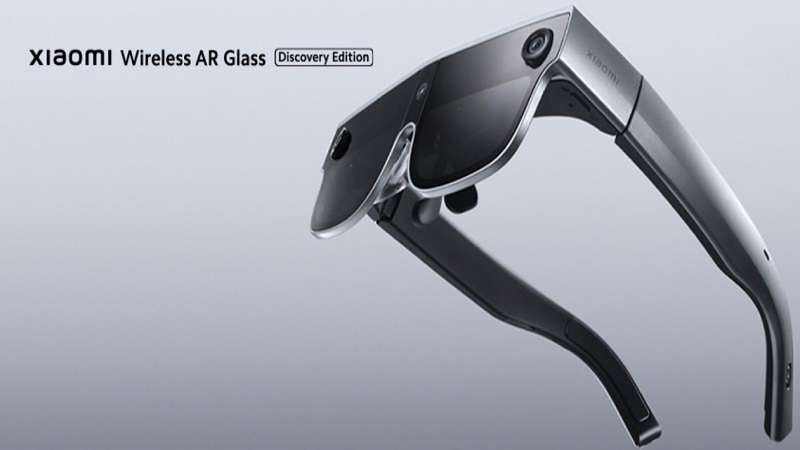Xiaomi has launched its Wireless AR Glasses featuring with retina-level adaptive display that adjusts to the lighting environment.
Xiaomi Wireless AR Glass is designed with individual experience in mind. Instead of relying on a wired connection to a host computing device, this device is designed at just 126g and adopts Xiaomi-developed high-speed interconnection buses to achieve high-speed data connection from smartphone to AR glasses.
Built on Snapdragon® XR2 Gen 1 Platform and featuring Xiaomi’s proprietary low-latency communication link, these Snapdragon Spaces™ XR Developer Platform-supported glasses offer a wireless latency of as low as 3ms1 between the smartphone device to the glasses, and a wireless connection with full link latency as low as 50ms2 which is comparable to wired solutions.
The AR glasses feature a lightweight design that incorporates a range of lightweight materials such as magnesium-lithium alloy, carbon fiber parts, and a self-developed silicon-oxygen anode battery. With a weight of just 126g, these glasses are designed to minimize any physical burden on the user.
Additionally, through analyzing tens of thousands of head tracking data samples, the glasses have been calibrated with precision, taking into account details such as the center of gravity, leg spacing, angle, nose rest, and other factors that contribute to a superior experience.
When angular resolution or PPD (pixels per degree) approaches 60, the human eye cannot distinguish granularity. The PPD of the Xiaomi Wireless AR Glasses is 58, which is the industry-leading closest to meeting this quality specification.
READ MORE: Xiaomi 13 Series with triple camera setup launched
Leveraging a free-form optical module that comprises a pair of MicroOLED screens, Xiaomi Wireless AR Glass also comes with free-form light-guiding prisms to achieve a clear picture display.
These free-form prisms are capable of performing complex light refraction in a limited volume. The content displayed on the screen is reflected by three surfaces within the light-guiding prisms, resulting in a final presentation in front of the user’s eyes.
The AR glasses’ optical module design minimizes light loss and produces clear and bright images with a to-eye brightness of up to 1200nit, providing a strong foundation for AR applications.
Additionally, the AR glasses come equipped with electrochromic lenses that can adapt to different lighting conditions. These lenses enable a blackout mode that offers an immersive experience when viewing content, while the transparent mode produces a more vivid AR experience that blends reality and virtual elements.
Xiaomi Wireless AR Glass also features an innovative self-researched micro gesture interaction that enables one-handed, highly-precise pure gesture interaction. This kind of interaction showcases one of the directions that Xiaomi believes human-computer interaction will take in the future.
Xiaomi utilizes the joints of the user’s inner fingers as a gesture recognition area for Xiaomi Wireless AR Glasses. The directional is oriented from the second joint of the middle finger, with the second joint of the index finger representing the upward direction.
When combined with the surrounding areas, this forms a four-way directional key for basic movement operations. In addition, the 12 knuckles function similarly to the Chinese nine-key input method, allowing for text input through thumb tapping in the finger area. The thumb sliding on the index finger is used to enter and exit applications.
Micro gestures on Xiaomi Wireless AR Glass enable users to perform daily app usage operations such as selecting and opening apps, swiping through pages, and exiting apps to return to the start page, all without using a smartphone for controls.
Xiaomi Wireless AR Glass incorporates a low power-usage AON camera that enables prolonged gesture interaction and facilitates features. Furthermore, users can also opt for conventional smartphone controls, which can be paired and used as a gesture or touchpad control.
Xiaomi’s extensive experience in cross-device interconnection has resulted in numerous innovative interconnection experiences being incorporated into wireless AR glasses.
The device supports a variety of large-screen applications available throughout the ecosystem, enabled by Mi Share’s application streaming capability. Popular applications like TikTok and YouTube can optimize display area usage of the glasses, essentially turning them into a portable large screen. Additionally, the AR capability allows users to place familiar apps anywhere in the viewing space and adjust their interface size via spatial gestures, thus enhancing the efficiency and overall experience of information access.
As the world’s largest smart home platform, Xiaomi has integrated AR to offer a unique experience to users. For instance, Xiaomi Wireless AR Glass allows users to “grab” the screen from a typical television screencast, and then continue watching it on the glasses.
Furthermore, Xiaomi has extracted common operations of smart devices, enabling users to operate devices through AR scenes. For instance, when looking at a lamp, users can use spatial gestures to click a virtual button to turn that lamp on or off. Xiaomi has also integrated a spatial audio experience, allowing virtual speakers to be linked with the real environment.
Xiaomi Wireless AR Glasses Discovery Edition requires pairing with Xiaomi 13 or other Snapdragon Spaces ready device. The glasses are available in a titanium-colored design and support three sizes of nosepieces. Nearsighted users can use an attachable myopic clip. In terms of software support, the glasses are compatible with Qualcomm Snapdragon Spaces, OpenXR, and Microsoft MRTK development framework. Xiaomi intends to work closely with developers to expedite the arrival of AR.
